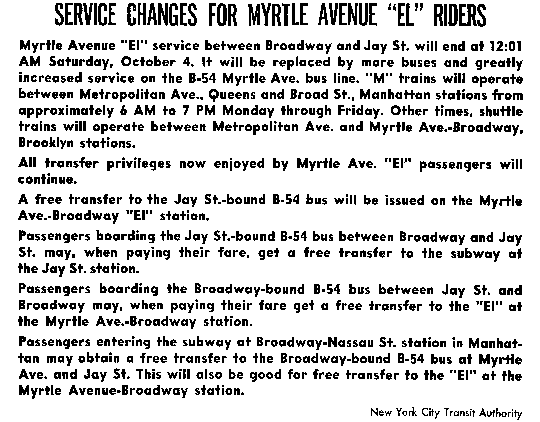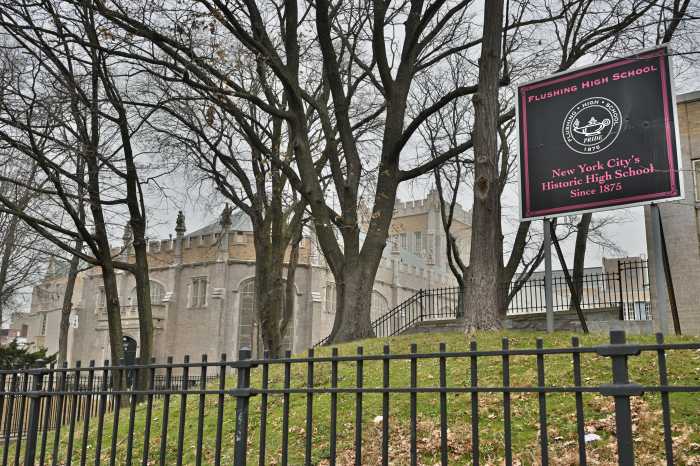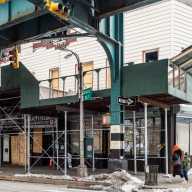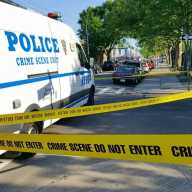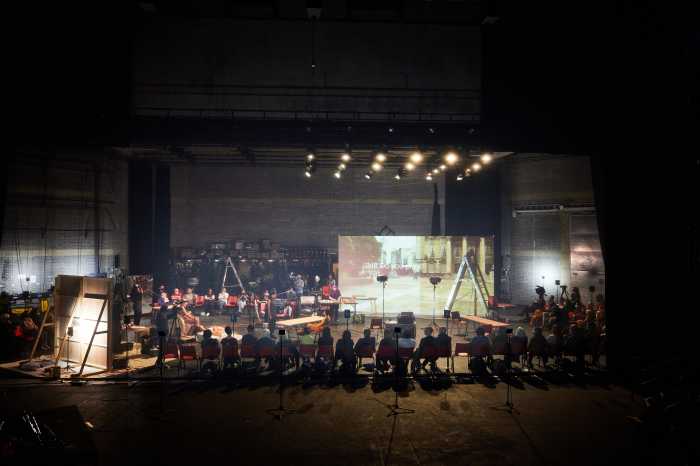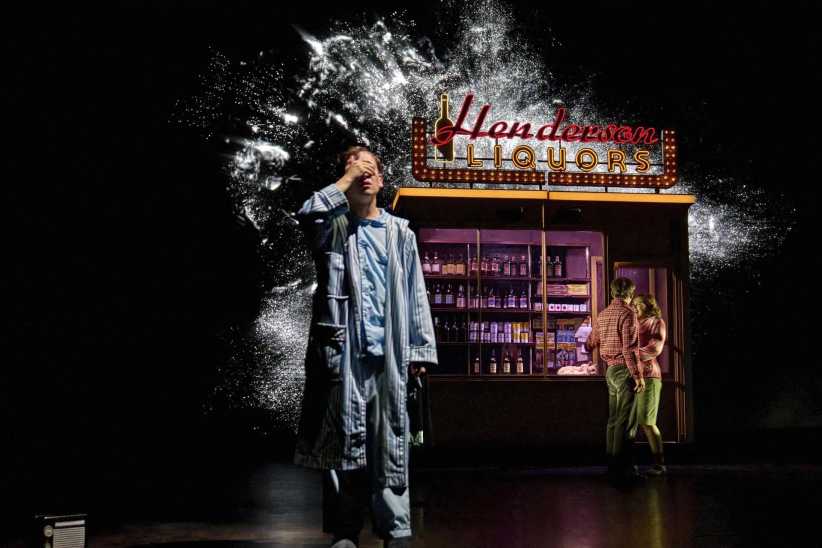Rusting away above the Myrtle Avenue-Broadway station on the J and M lines in Bushwick is a reminder of the first major commuter train that linked Ridgewood and surrounding communities to the business hubs of Downtown Brooklyn and Lower Manhattan.
The last steel trusses of the old Myrtle Avenue Elevated Line (El) tower over Myrtle Avenue from Lewis Avenue in neighboring Bedford-Stuyvesant to the curvy spur where M trains shift between the elevated Broadway Line and the existing Myrtle Avenue Line that runs through Bushwick and Ridgewood to Metropolitan Avenue in Middle Village.
Trains last ran on the Myrtle Avenue El in October 1969, which — by that point — deteriorated greatly from overuse, neglect and urban decline. Nonetheless, it played an important role in accelerating the transition of our neighborhood from rural to urban life, spurring the construction of communities filled with apartment houses, single-family homes and small businesses that remain vibrant to this day.
Brooklyn Rapid Transit (BRT, later reorganized as Brooklyn Manhattan Transit [BMT]) developed the Myrtle Avenue El, with the first section opening in April 1888. At first, it was a shuttle line connecting Adams Street in Downtown Brooklyn to Grand Avenue in Clinton Hill.
Development of the line continued into Queens in 1890, when it reached Wyckoff Avenue in Ridgewood. From there, the Myrtle Avenue El moved to ground level and ran through Ridgewood along Palmetto Street and the former Lutheran Line (named for the nearby cemetery) to its terminus at Metropolitan Avenue in Middle Village.
At first, heavy steam locomotives pulled the Myrtle Avenue El trains. By 1900, the entire line was electrified via third rail technology. This enabled the BRT to introduce lighter train cars capable of crossing the Brooklyn Bridge. Thus, a rail line was constructed in Downtown Brooklyn running the Myrtle Avenue El over the famed bridge to Park Row in Lower Manhattan, which became the line’s western terminus.
Raising it in Ridgewood
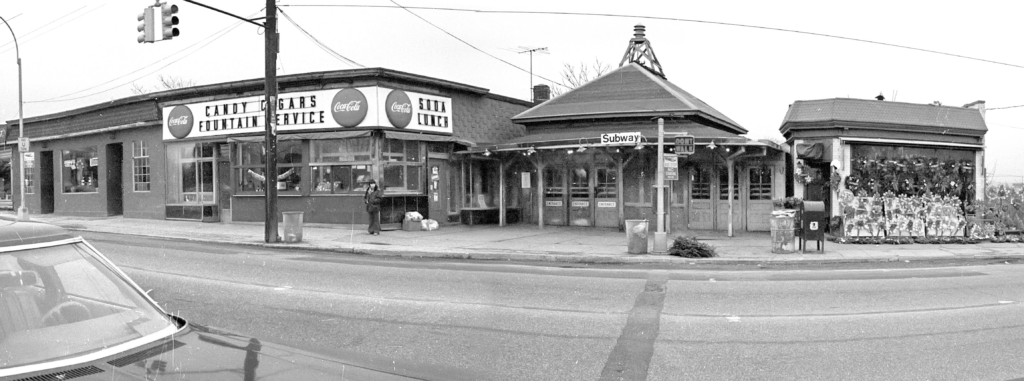
(RIDGEWOOD TIMES/file photo courtesy of Patrick Cullinan)
In early February 1913, the city’s Public Service Commission announced that it had granted the BRT permission to elevate the 1 1/2-mile section of the Myrtle Avenue Line from Wyckoff Avenue to just east of Fresh Pond Road. This was done to eliminate some of the congestion at the Ridgewood depot at the corner of Myrtle and Wyckoff avenues.
Prior to this, there were low-level stations at Seneca Avenue, Forest Avenue, Fresh Pond Road and Metropolitan Avenue. From Wyckoff Avenue to Fresh Pond Road, the at-grade railroad was fenced in on each side and the only crossings were at the stations.
Shortly thereafter, the BRT placed contracts with Frederick C. Burnham to build the 1 1/2-mile elevated railroad, but one of the conditions was that he had to do so while maintaining service on the railroad to Metropolitan Avenue so as to not inconvenience local residents.
In turn, the Manhattan-based Burnham hired various subcontractors including Million Brothers Company to erect the steel and Empire Construction Company to lay the steel rails when the steel structure was completed.
Prior to the erection of the new elevated section, a dangerous reverse curve led the trains from the elevated level to the ground level at Myrtle and Wyckoff avenues, across from the car yards. This was eliminated and replaced by a single curve from Myrtle Avenue into Palmetto Street.
By May 1914, all of the concrete had been poured and about 35 percent of the steel work had been completed. In September 1914, the Empire Construction Company started laying rails.
On Feb. 15, 1915, the new section of the elevated railroad was placed into service from Wyckoff Avenue to Fresh Pond Road. Shortly thereafter, the private right-of-way on the surface of Palmetto Street was made available for electric trolley service. The Fresh Pond Storage and Service Yards were enlarged on the east side of Fresh Pond Road at Putnam Avenue to hold 700 cars.
The BRT purchased additional land at a $20,000 cost to accomplish this. They also built a concrete clubhouse for the trainmen as the move to switch some of the trolley lines that had formerly terminated at Ridgewood Depot to Fresh Pond Depot.
The lost stations
Later dubbed the MJ line, the Myrtle Avenue El ran on the current M line between Metropolitan Avenue and Central Avenue in Bushwick, then continued above Myrtle Avenue to Bridge-Jay Street.
Along the way, it served the communities of Bedford-Stuyvesant, Fort Greene and Clinton Hill, with stops located at Broadway (above the Myrtle Avenue J train station), Sumner Avenue, Tompkins Avenue, Nostrand Avenue, Franklin Avenue, Grand Avenue, Washington Avenue, Vanderbilt Avenue and Navy Street.
For decades, residents used the line to not only businesses in downtown Brooklyn and Manhattan, but also the Brooklyn Navy Yard, which — during World War II — employed 70,000 people. Students also relied on the Myrtle Avenue El to reach schools such as St. Joseph’s College and Bishop Loughlin High School, both in Clinton Hill.
End of the line
Many factors led to the Myrtle Avenue El’s downfall. One of the first occurred during the late 1930s, when the underground G line opened between Brooklyn and Queens. The Crosstown Line, as it is called, served many of the same communities as the Myrtle Avenue El and offered an important north-to-south link to other subway lines and points of interest.
The El suffered another blow in 1944, when the BMT ended its trips across the Brooklyn Bridge. The line then terminated at Bridge-Jay Street.
New York City began to decline financially during the 1950s and 1960s, as waterfront industry fled and middle-class residents left the city for the suburbs. The state and federal governments also invested tens of millions of dollars in constructing expressways bisecting the boroughs — but provided little to support the city’s transit system.
In its last few years, the Myrtle Avenue El became symbolic of public transit decay. It was the only line still using wooden passenger train cars; modern steel cars were used everywhere else in the subway system. The elevated stations— many of which were still lined with wood plank platforms—also deteriorated greatly.
In July 1969, the MTA announced that it would be shutting down the Myrtle Avenue El — a move which Ridgewood lawmakers immediately protested. In the July 24, 1969 Ridgewood Times, Assemblyman John Flack and Assemblywoman Rosemary Gunning “called for a public hearing before any action is taken to discontinue the present service.”
Flack and Gunning, in a letter to then-MTA Chairman William Ronan, argued that “the elimination of train service to downtown Brooklyn will create severe hardship and great inconvenience to workers, students, shoppers and other residents who must use the line daily.”
Ronan, however, noted that the declining ridership made it a losing proposition to continue. “In addition to operating savings and increased revenue from the bus service” that would replace it, he reportedly said, “demolition of the elevated structures will open a 35-block stretch of Myrtle Avenue to light and air.”
The end finally came for the Myrtle Avenue El in October 1969, when New York City Transit ended service west of Myrtle Avenue-Broadway to Bridge-Jay Street. The New York Times reported that about 1,200 people rode the final cars to pass the line.
In the years that followed, the elevated structure west of Lewis Avenue was taken down piece by piece. While Ridgewood, Bushwick and Middle Village residents are still connected by rail to the rest of the city via the M line, there remains no direct rail link to Downtown Brooklyn.
Now, 45 years after the Myrtle Avenue El’s demise, western Queens and Downtown Brooklyn are booming once again. Perhaps the line, had it survived, could have bounced back the way the city did after decades of decline — but we will never know for certain.
Source: The July 24, 1969, and Dec. 11, 2014, issues of the Ridgewood Times.
***
Share your history with us by emailing editorial@ridgewoodtimes.com (subject: Our Neighborhood: The Way it Was) or write to The Old Timer, ℅ Ridgewood Times, 38-15 Bell Blvd., Bayside, NY 11361. Any mailed pictures will be carefully returned to you upon request.



